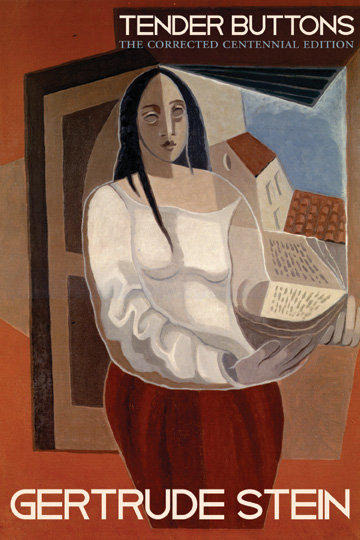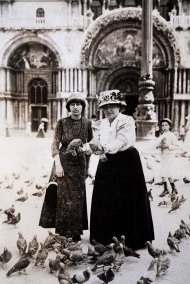|
The Steiny Road Poet offers this look at:
Tender Buttons: The Corrected Centennial Edition
by Gertrude Stein as edited by Seth Perlow.
City Lights Books, 2014
Price $9.95, trade paperback, 134 pp.

Even in anything-goes Paris of 1910, Gertrude Stein clandestinely celebrated her marriage to Alice B. Toklas. By 1914, Tender Buttons, her coded love poem to the woman who would become her lifelong partner, realized print publication. With the contemporary inroads for same sex marriages, the spring release of Tender Buttons: The Corrected Centennial Edition by Gertrude Stein as edited by Seth Perlow is expected to excite readership beyond the usual academic community. While some have called Stein the "People's Modernist," reviewing this still cutting-edge work that points to Stein's illicit union with Toklas requires sensitivity to a broader audience unfamiliar with Stein's literary experimentation.

THE PUBLISHER'S MISTAKES
A graduate of the 1898 Harvard Annex-Radcliffe College, Gertrude Stein allowed Tender Buttons, her first book of poetry to be published by the small press Claire Marie of New York. Her friend Carl Van Vechten (later her literary executor) had recommended that Claire Marie founder Donald Evans publish something by Stein, possibly plays. However, Stein sent Evans the three sections that would become Tender Buttons. Evans helped shape the long poem by reordering the sections and asking Stein to create a title for the overall work. He also helped introduce some of the mistakes because the deadline for review by the critics would not wait for Stein's galley corrections to cross the Atlantic and so she permitted Evans to proof on his own.
2014 ushers The Corrected Centennial Edition (City Lights Books, San Francisco) of the uniquely written cubist prose poem that draws on Stein's scientific background. What distinguishes this edition from others is over 100 edits, some indicated by Stein in her unmistakable handwriting found by editor Perlow in a first-edition copy held at the University of Colorado, as well as other corrections gleaned from her papers at Beinecke Library of Yale University and from the Library of America edition. Besides the three sections of the poem with all amendments incorporated and the appendix of corrections, The Corrected Edition also includes images of Stein's handwritten corrections, "A Note on the Text," by Perlow, and an "Afterword," by Juliana Spahr.
THEN, WHAT IS THE QUESTION
Those who know anything about Stein are probably familiar with her last conversation with Toklas during which, Stein, dying of cancer, asked, "What is the answer?" When nothing was said, Stein supposedly laughed and said, "Then, what is the question?" The same applies to Tender Buttons whether it is the reading of this enigmatic but playful oeuvre or the correcting of such a difficult work in which, it may not be clear that one word or punctuation correction over another would make a difference. While expectation of answers hovers around this edition, questions nonetheless begged to be asked. Who is Seth Perlow and what makes him qualified to undertake this project of repair? Who is Juliana Spahr and what gives her license to interpret Tender Buttons? Why does Perlow say that he intends this edition to be "accessible to casual readers as it is reliable for more serious students of Stein's writing?" How did City Lights, as opposed to a university press, come to publish this edition?
MIXING HIGH AND LOW
The Committee on Scholarly Editions of the Modern Language Association (MLA) has authorized this version as the "Approved Edition" of Tender Buttons. What does that mean? The MLA, founded in 1883 with nearly 30,000 members in 100 countries today, promotes and provides a forum for scholarly projects such as corrected editions of modern language works. Their stamp of approval gives credibility to Dr. Perlow, an assistant professor of English at Oklahoma State University where he teaches American literature, poetry and poetics, new media studies, and gay and lesbian literature. The MLA approval also endorses his decision to invite award-winning poet, critic, and scholar Juliana Spahr to comment on Stein's long poem. However, the MLA approval moves this edition squarely into the category of an academic book, a classification that might have both pleased and consternated Stein. Why so? Stein, like Perlow—by the way, he is also a poet—believed that anybody could read and enjoy her work.
The MLA publishes most of its journal articles (PLMA) on topics dealing with the work of deceased writers. As Dr. Spahr points out in her reader-friendly Afterword, Tender Buttons took a lot of jabs from the critics. While Stein had already self-published two works of fiction—Three Lives and The Making of Americans: Being a History of a Family's Progress—Tender Buttons was her first invited publication and its arrival marked a battery of derisive criticism still continuing among critics who have skimmed but not studied the work.
HOW STEIN'S CORRECTIONS CROSSED THE ATLANTIC
What led Perlow into this project was learning about the first-edition copy held at the University of Colorado that was marked up in Stein's handwriting. The copy, which belonged to Donald Sutherland, was most likely given to him by Stein when he visited her just as the Americans were liberating France from Nazi Germany in World War II. Perlow is not the first scholar to look at this annotated copy of Tender Buttons, but he was the first to act on it and to thoroughly examine all sources that shed light on Stein's intentions for the text. His sources include the handwritten manuscript, the typescript produced by Alice Toklas, the first edition published by Claire Marie, Stein's handwritten corrections on paper torn out of her manuscript notebook now located in her archive at Yale's Beinecke Library, Stein's corrections in Donald Sutherland's copy of the first edition, and the Library of America edition. He used the latter edition as the contemporary touchstone when decision-making for edits was unclear.
THE ARRAY OF 137 VARIANCES
In Perlow's words, "This edition arbitrates a total of 137 variances in matters of wording, spelling, punctuation, and formatting." More than half of the edits deal with spelling (72) and slightly less than half of the spelling edits (35) concern British versus American conventions. While British spellings of words like "centre" and "colour" have been Americanized, some British spellings (e.g. "authorised") remain in accordance with Stein's manuscript.
However, some spelling corrections are linguistically, if not semantically, clarifying—the corrected word fits better with the other words. For example in the subpoem "A Substance in a Cushion.", the word "clear" corrects the first edition use of "clean" in this sentence: "Supposing you do not like to change, supposing it is very clear that there is no change in appearance, supposing that there is regularity and a costume is that any the worse than an oyster and an exchange." In "Lunch.", the word "beads" corrects the first edition use of "beds" in this sentence: "A real cold hen is nervous is nervous with a towel with a spool with real beads." The word "beads" offers the possibility that the towel contains a spool of noisy beads being shaken at the hen, making the bird nervous. In the 18th stanza of "Rooms" ("Rooms," the third section of Tender Buttons, has no titled subpoems) the word "bead" corrects the first edition use of "head" in this sentence partially quoted here: "…it showed the whole bead that had a hole and should have a hole it showed the resemblance between silver."
Some spelling amendments add to the mystery of what Stein was presenting. For example, her insistence on an antiquated spelling of the singular "potato" as "potatoe." Also some words are split apart, increasing poetic rhythm, but not enhancing logical word choice (e.g. "excellent" becomes "excel lent" as in "Excel lent not a hull house, not a pea soup, no bill no care, no precise no past pearl pearl goat.").
Only fourteen percent of the variances involved a word or words that required insertion (because the word was missing), deletion, or rearrangement. One of the more interesting examples (because it points to Stein playing with philosophic concepts of being) adds an extra "and is" in this sentence partially quoted here: "…why is it when it is and why is it when it is and is and there is no doubt, there is no doubt that the singularity shows."
Because Stein had pronounced ideas about punctuation, such as not believing in the use of question or exclamation marks and that commas were "servile" and best ignored, the forty edits related to Perlow's "addition or removal of hyphens, commas, periods, umlauts, and in one case, quotation marks" achieve a higher level of interest for those who know Stein's writing habits. From "A Little Called Pauline." consider this sentence where a comma was inserted after "leading"—"Bidding a wedding, widening received treading, little leading, mention nothing." The comma makes a strong case that "leading" is an active verb like "bidding," widening," "treading" versus a present participle acting as an adjective to "mention," which could be a noun without the comma.
APPROACHING THE SUI GENERIS BUTTONS
Ever since publication of Stein's one-of-kind Tender Buttons—and even for Stein, this work is sui generis—the amount of effort to read a Modernist work, including work of those writers taking inspiration from Stein and her contemporaries like Ezra Pound, James Joyce, and Virginia Wolf, increased exponentially. Will Tender Buttons: The Corrected Centennial Edition attract a new group of casual readers? Perhaps. Best bet for a novice though would be to read this book slowly with a study group.
Afterwords
The Steiny Road Poet recommends that serious study of Tender Buttons includes Perlow's Corrected Edition and another edition such as the one published by Dover Publication (1997). The typeface in the City Lights Corrected Edition is tiny and faint, and therefore hard to read. The odd thing is that City Lights uses a slightly bigger and bolder typeface for Perlow's "A Note on the Text," the "List of Variances," and Spahr's "Afterword."
Steiny invites the seriously curious to the next session of Coursera's Modern and Contemporary American Poetry (ModPo begins September 6, 2014, signup now) where Steiny will be leading an in-depth study of Section 2 "Food" of Tender Buttons. Her study group happens inside the ModPo Discussion Forums. Proceedings of the study sessions on Section 1 "Objects" can be accessed now at The Steiny Road to Operadom blog.
|